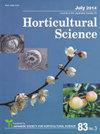Growth and Yield of ‘Budousanshou’ Grafts on ‘Fuyuzanshou’ and ‘Karasuzanshou’ Rootstocks
Journal of The Japanese Society for Horticultural Science
Pub Date : 2013-10-01
DOI:10.2503/JJSHS1.82.312
引用次数: 0
Abstract
The growth and yield of ‘Budousanshou’ ( Zanthoxylum piperitum (L.) DC. f. inerme Makino) trees were compared between grafts on ‘Fuyuzanshou’ ( Z. alatum Roxb. var. planispinum Rehd. et Wils.) seedlings and ‘Karasuzanshou’ ( Fagara ailanthoides Engl.) seedlings. Comparisons were made for 8 years after transplanting. The tree height for grafts on ‘Karasuzanshou’ rootstock was greater than for ‘Fuyuzanshou’ grafts throughout the experimental period after transplanting. For both graft treatments, tree height did not increase beyond 6–7 years after transplanting, suggesting that the trees had reached maturity. In addition, the canopy volume of grafts on ‘Karasuzanshou’ rootstock was greater than that on ‘Fuyuzanshou’ rootstock at 2 years after transplanting. The yield per tree and canopy volume were higher for grafts on ‘Karasuzanshou’ than grafts on ‘Fuyuzanshou’ rootstock by 7 years post-transplanting (i.e., the mature stage). Due to its greater canopy volume, the per tree yield of mature ‘Karasuzanshou’ grafts has the potential to be greater than that from ‘Fuyuzanshou’; therefore, ‘Karasuzanshou’ is a good candidate rootstock for the effective production of Japanese peppers.‘百花散秀’嫁接在‘扶养赞秀’和‘卡拉赞秀’砧木上的生长和产量
花椒花椒的生长与产量研究直流。对“扶养赞寿”(Z. alatum Roxb.)上的嫁接进行了比较。平棘变种。(et wills .)幼苗和' karasuzanshow ' (Fagara ailanthoides Engl.)幼苗。移植后8年进行比较。嫁接后整个试验期内,‘卡拉赞寿’砧木的树高均大于‘扶养赞寿’砧木。两种嫁接处理的树高在移植后6-7年之后都没有增加,表明树木已经成熟。嫁接后2年,嫁接在‘卡拉赞寿’上的冠层体积大于嫁接在‘扶养赞寿’上的冠层体积。移栽后7年(即成熟期),嫁接在‘卡拉赞寿’上的单株产量和冠层体积均高于嫁接在‘扶养赞寿’砧木上的。由于‘卡拉赞寿’的冠层体积更大,成熟嫁接的单株产量有可能大于‘扶养赞寿’;因此,“卡拉赞秀”是有效生产日本辣椒的良好候选砧木。
本文章由计算机程序翻译,如有差异,请以英文原文为准。
求助全文
约1分钟内获得全文
求助全文
来源期刊
自引率
0.00%
发文量
0
审稿时长
>36 weeks

 求助内容:
求助内容: 应助结果提醒方式:
应助结果提醒方式:


